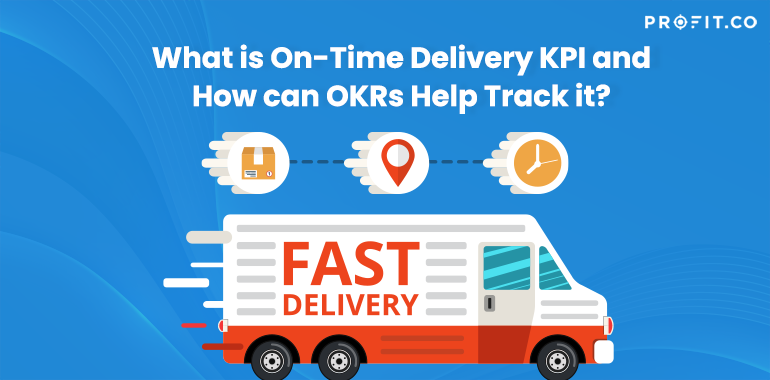As a cornerstone for evaluating customer contentment, retention, and loyalty, OTD also plays a significant role in streamlining operational processes, minimizing costs, and securing a competitive edge in the market. Let’s see how tracking OTD can help you achieve skyrocketing goals in this blog.
“Customers don’t measure you on how hard you tried, they measure you on what you deliver.”
Understanding On-time Delivery KPI
The essence of the OTD KPI is to track and improve the punctuality of customer deliveries. It is a straightforward yet powerful metric that can significantly impact customer loyalty, brand reputation, and overall competitiveness.
Not sure where to start? Schedule a free session with our OKR experts to boost OTD!
The Formula for Calculating On-time Delivery
The formula for calculating the OTD rate is

Number of On-time Deliveries: is the count of shipments or projects successfully delivered on or before the agreed-upon delivery date.
Total Number of Deliveries: encompasses all deliveries made within the same period.
Real-life Example
Let’s consider a hypothetical company, “FastTech Electronics,” specializing in consumer electronics. FastTech committed to delivering 1000 units of the latest smartphone model to various retailers in March. Of these, 970 units were delivered on or before the agreed date, while the remaining 30 units experienced delays due to logistical challenges.
Using the formula:
OTD Rate = ( 970/1000 ) ×100 = 97%,
This means FastTech Electronics achieved a 97% OTD rate for March, indicating high efficiency and reliability in its delivery process.
Importance of On-time Delivery KPI
The significance of the On-time Delivery (OTD) KPI cannot be overstated, as it directly impacts several critical aspects of a business’s success.
Customer Satisfaction
Ensuring deliveries are made as promised is essential for building and maintaining customer trust. For instance, an online retailer that consistently delivers orders on the promised date will likely see higher customer satisfaction. This reliability fosters a positive shopping experience, leading to repeat business and positive reviews. Imagine a scenario where a customer orders a birthday gift with the assurance it will arrive in time for the celebration. The on-time delivery of this gift not only meets but potentially exceeds customer expectations, cementing their loyalty to the retailer.
Performance Measurement
OTD acts as a crucial metric for assessing the efficiency of a company’s supply chain and logistics. Consider a manufacturing company tracking OTD to identify delays in its supply chain. By pinpointing that a frequent bottleneck occurs during the quality control stage, the company can implement specific improvements to expedite processes, enhancing overall performance.
Competitive Advantage
In highly competitive markets, reliably meeting delivery times can set a company apart. A furniture manufacturer that guarantees and meets a 2-week delivery window for custom orders, in contrast to the industry standard of 4 weeks, gains a competitive edge by appealing to customers who value speed and reliability.
Operational Efficiency
Monitoring OTD rates help businesses uncover and address inefficiencies. For example, a logistics firm analyzing OTD data might discover that a particular shipping route frequently causes delays. By adjusting to a more efficient route or carrier, the firm can improve its OTD rate, reduce costs, and strengthen its relationships with suppliers and customers through enhanced reliability.
In summary, the On-time Delivery KPI is not merely a measure of timeliness but a comprehensive tool for improving customer satisfaction, operational performance, and competitive positioning through the lens of real-world examples that illustrate its impact on various aspects of business operations.
Strategies to Improve On-time Delivery
Improving On-time Delivery (OTD) involves strategic initiatives to enhance the accuracy, efficiency, and reliability of a company’s supply chain. These strategies are illustrated with practical examples:
Enhanced Forecasting and Planning
A retail clothing chain utilizes predictive analytics to better forecast fashion trends and seasonal demand, enabling it to adjust its inventory and production plans in advance. By doing so, the chain ensures it has the right stock levels to meet customer demand promptly, thereby improving its OTD rates.
Supplier Management
A computer manufacturer develops a comprehensive supplier scorecard that evaluates suppliers not just on cost but on their reliability, quality, and delivery performance. Regular reviews and feedback sessions help suppliers align more closely with the manufacturer’s requirements, leading to improvements in component delivery times and the final product’s OTD.
Process Optimization
An e-commerce company conducts a thorough analysis of its order fulfillment process and identifies that the packing and shipping phase is a bottleneck. By reorganizing the warehouse layout, introducing automated packing systems, and training staff on more efficient techniques, the company significantly reduces the time from order receipt to dispatch, improving its OTD performance.
Technology Integration
A logistics firm adopts state-of-the-art supply chain management software that offers end-to-end visibility of its operations, from warehousing to transportation. This technology enables the firm to monitor inventory levels in real time, anticipate delivery issues before they arise, and adjust routes dynamically to avoid delays, thus enhancing OTD.
Customer Communication
A furniture delivery service implements a customer portal that provides real-time updates on order status, from production to delivery. If delays are anticipated, the service proactively informs customers and offers solutions or compensation. This approach improves customer satisfaction and mitigates the negative impact of delays on the company’s OTD performance.
Using OKRs to Measure On-Time Delivery KPI
Crafting Objectives and Key Results (OKRs) for improving On-Time Delivery (OTD) KPI involves setting clear, measurable goals and defining actionable steps to achieve them. Here’s how you can structure OKRs for OTD:
Objective: Boost On-Time Delivery to Streamline Operations
- KR 1: Increase OTD rate from 80% to 95%
- KR 2: Reduce the percentage of deliveries experiencing delays due to inventory shortages from 20% to 5%
- KR 3: Decrease the percentage of orders impacted by supplier-caused delays from 15% to 5%
Initiatives:
- Introduce a real-time tracking system for better visibility of shipments.
- Deploy an automated inventory management system to forecast and replenish stock efficiently.
- Establish a supplier evaluation and feedback loop to improve performance.
Final Thoughts
Improving on-time delivery is a journey that never really ends. It’s about tackling challenges head-on and grabbing opportunities as they come. By focusing on timely deliveries, businesses can build stronger trust with their customers, stand out in the market, and achieve outstanding operational performance. This effort to boost on-time delivery shows a company’s dedication to being the best. Every step forward in this area makes a big difference, turning everyday tasks into exceptional achievements.
Achieve your on-time delivery goals with OKRs!
Related Articles
-
ARR Multiple: A Key Metric for SaaS Valuation
In the Software-as-a-Service (SaaS) Industry, understanding how a company is valued is crucial for both founders and investors. One metric... Read more
-
Abandoned Checkouts: Why They Happen and How to Fix Them
In e-commerce, few challenges are as persistent and as costly as abandoned checkouts. Despite a shopper's clear intent to buy,... Read more
-
From Baseline to Target: Mastering the Science of KPI Progress
KPIs (Key Performance Indicators) are more than just numbers on a spreadsheet they're the compass that guides your business toward... Read more
-
Understanding Planned Value and Its Importance in Project Management
In project management, monitoring and measuring progress are essential to ensuring that projects stay on track and deliver expected results.... Read more

